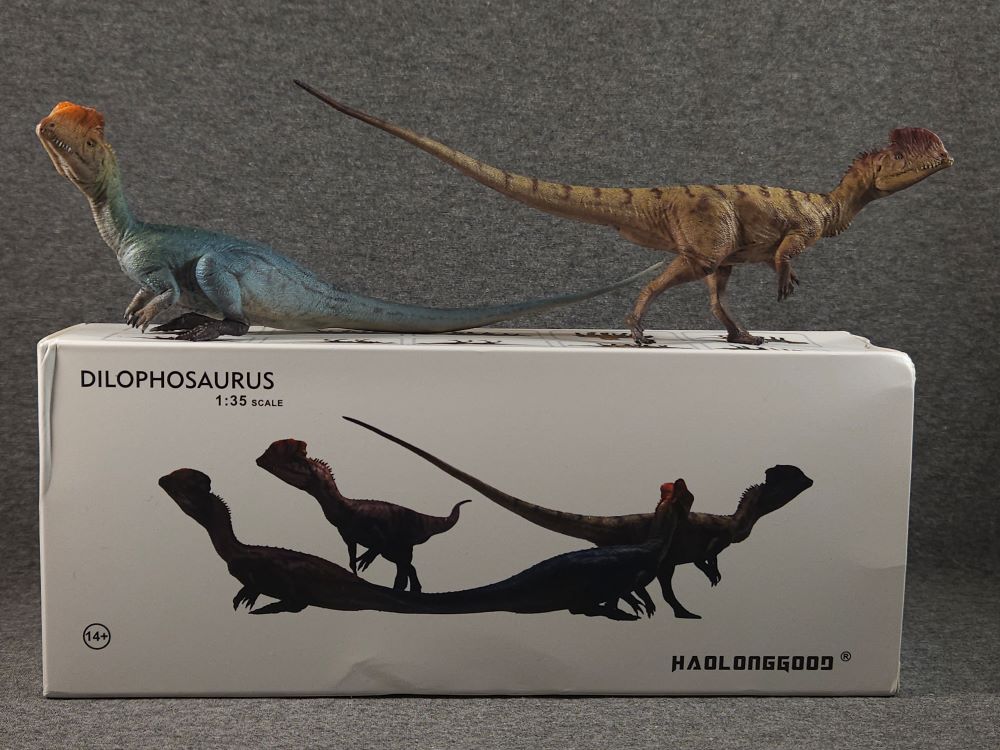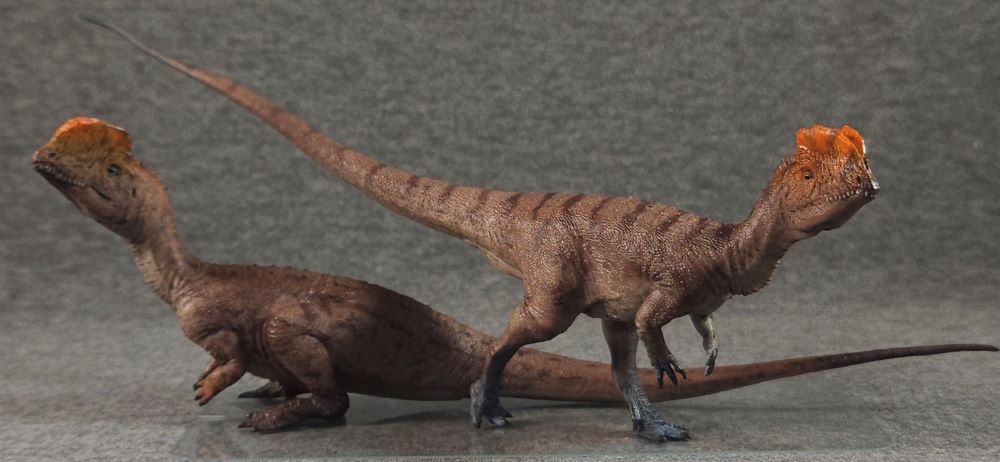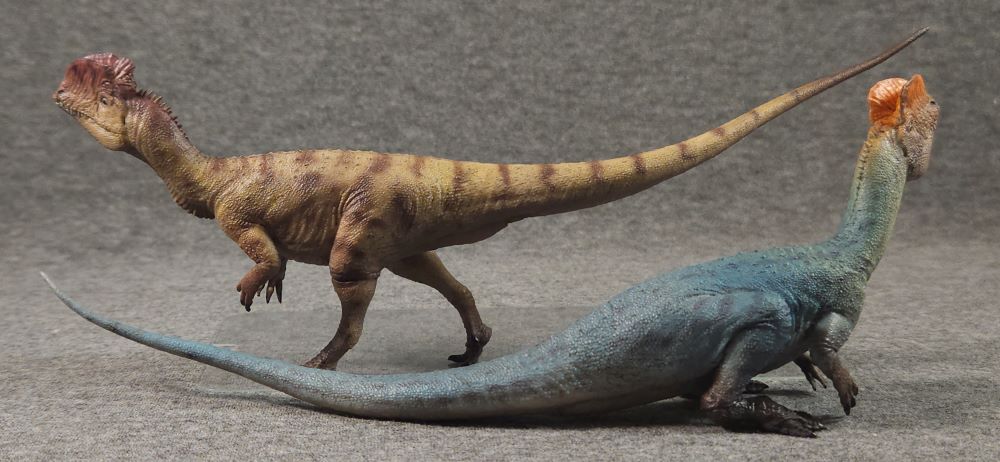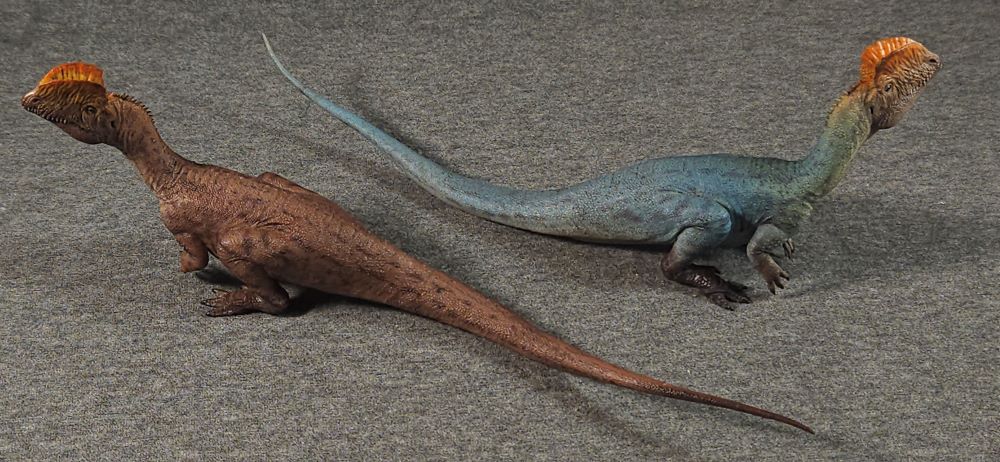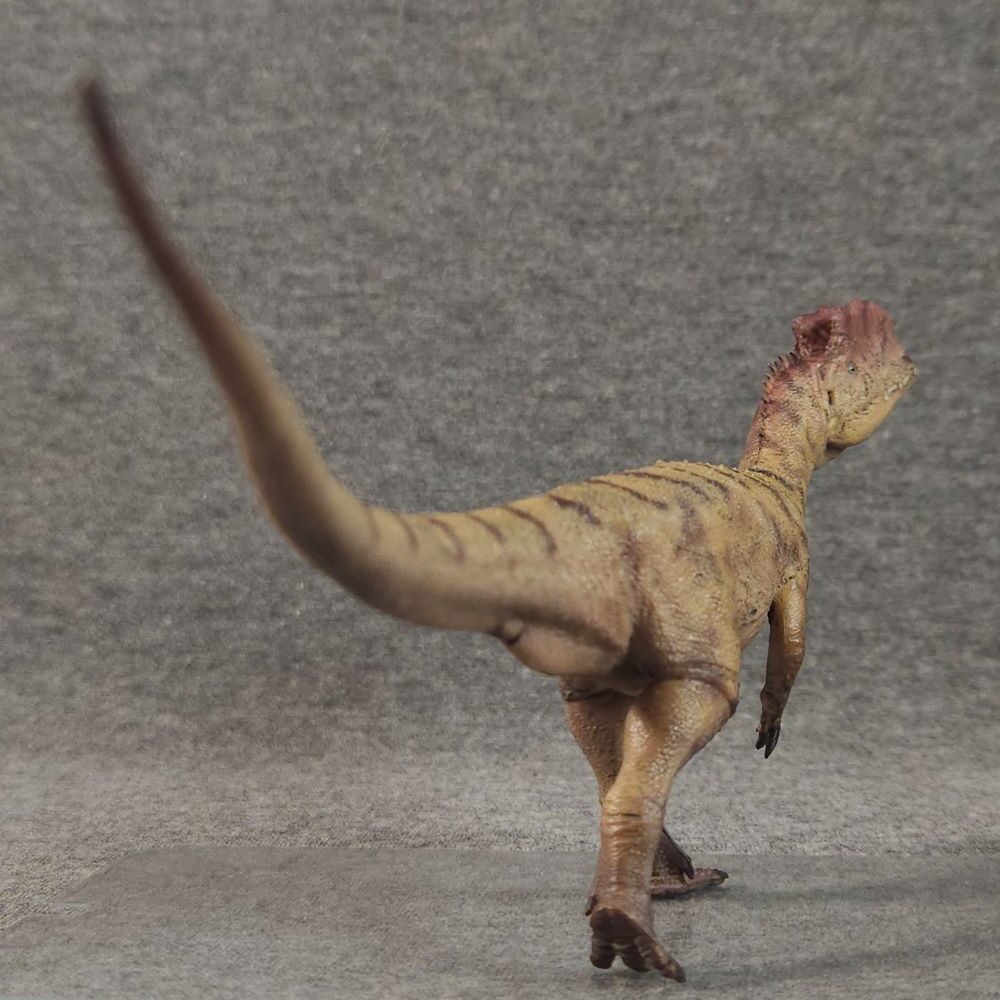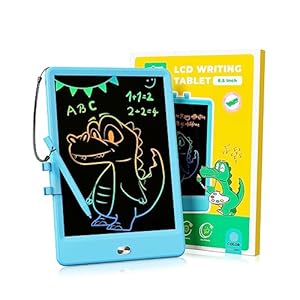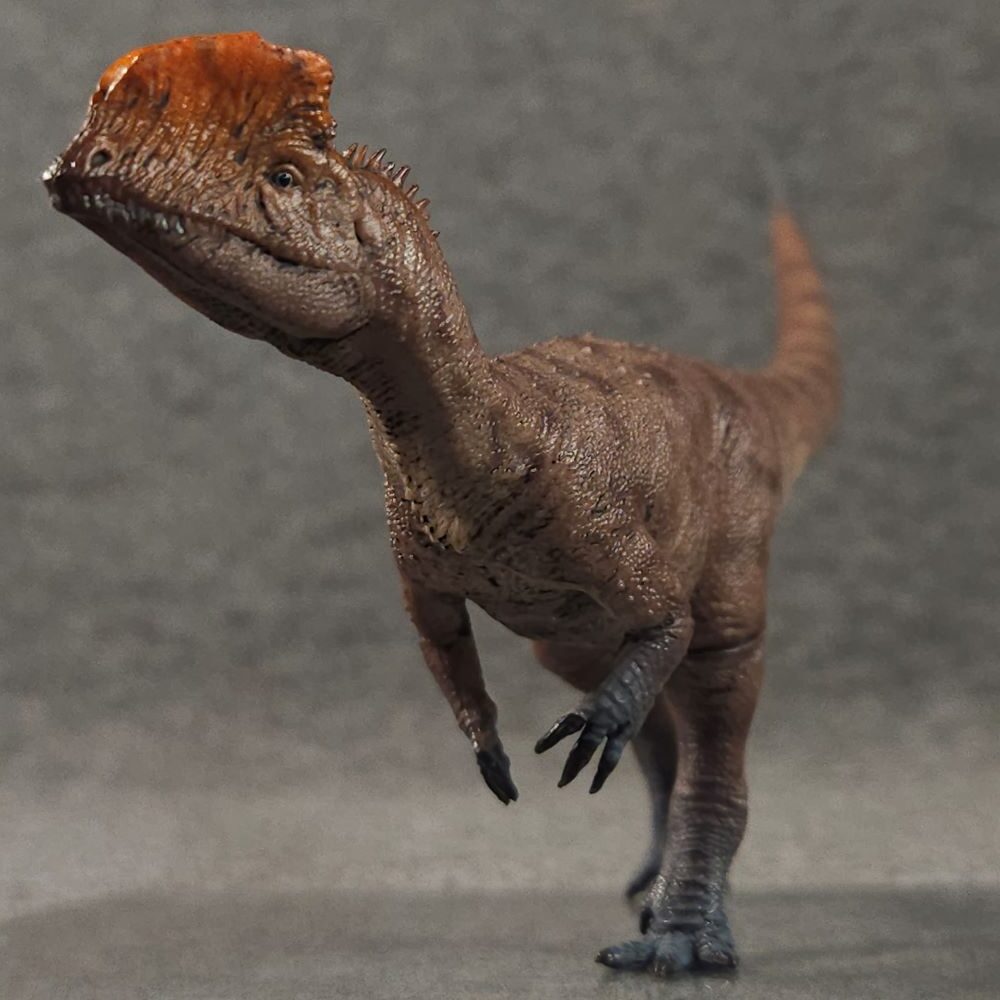
Although I grew up with dinosaur toys around me for as long as I can remember, there was one dinosaur missing from my collection as a small child. This dinosaur, which I desired more than almost any other, was the “two-crested reptile”, Dilophosaurus. With its elaborate head crests and fierce-looking notched jaws, Dilophosaurus was an early favorite of mine. The animal’s place in the fossil record is fascinating as well – Dilophosaurus was something of a trendsetter for predatory dinosaurs in the early Jurassic. With the disappearance of most competitors after the Triassic Mass Extinction, Dilophosaurus became the largest living land animal on the planet for several million years (as far as we know for now), and reigned as the apex predator on what would eventually become the North American continent. Dilophosaurus was a big, remarkable creature heralding even bigger and more remarkable creatures to come.

Nearly all the major toy/collectible brands making dinosaurs over the last decade+ have had a go at the Two-Crested Reptile, and plenty of other multimedia content has featured the theropod as well – even if they’re only imitating Jurassic Park’s extremely fictionalized interpretation of the animal. One of the latest contenders to the collectible market comes from Haolonggood, who has been tackling a variety of dinosaur genera which have rarely if ever been produced on the toy market, or have been long overdue for a revisit. Being a lifelong enthusiast of the genus, I have to admit: for all the attempts made at the animal, few Dilophosaurus toys to date have truly satisfied me. I was eager for Haolonggood’s take to arrive, and determine if this would be the one to finally sate my appetite.
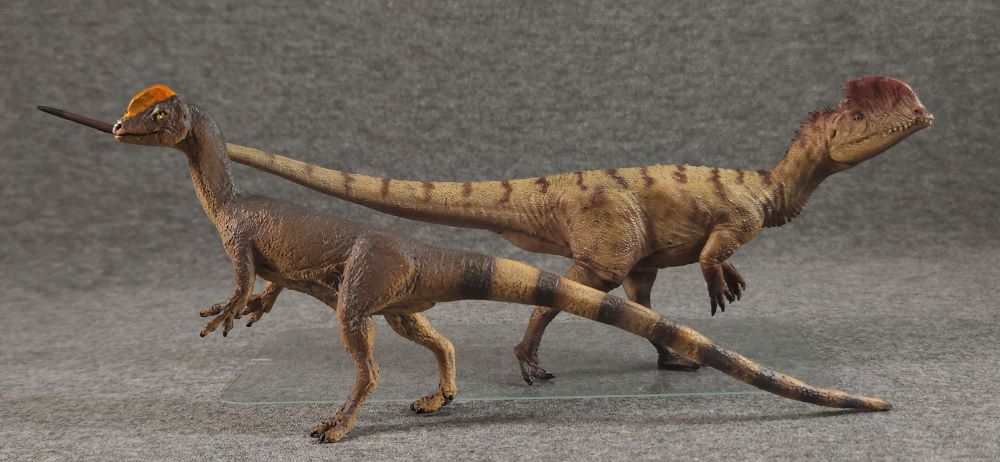
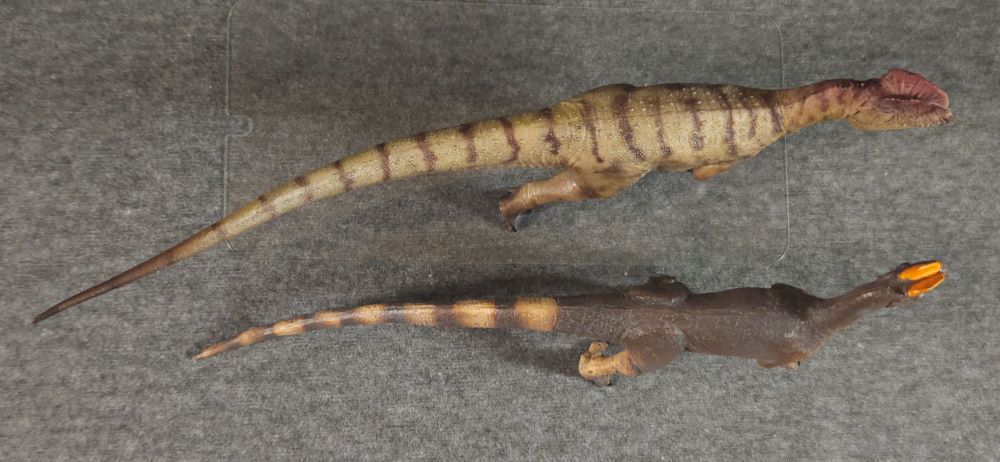
Haolonggood’s Dilophosaurus marks the fourth theropod figure released by the company since their resurgence in early 2023. However, Dilophosaurus is unique so far in the company’s repertoire for being sold as a pair – buyers actually get two crested theropods in one package (perhaps a callback to the classic Carnegie Collection pair? It makes for a nice thought, at least). The figurines are packed neatly in plastic sleeves and foam padding, within a clean white box featuring the typical genus label and company branding around official photographic art. There are two variants of the set, with a check underneath the box designating the version inside. Each pair has unique names for the individuals: Sun Xin + Gu da sao for the brown pair, and Wang Ying + Hu Sang Niang for the blue/yellow pair. There is no apparent indication which name goes to which individual in their respective pairs.
Rather than going for a combative display like the classic Carnegie figures, with the pair reared and snarling in popular media-dino fashion, the Haolonggood Dilophosaurus couple is refreshingly relaxed, with one individual seated on the ground and the other individual casually striding by. Only the dinosaurs’ tilted heads, snouts pointed into the air, belie the animals’ alertness. The standing figure is balanced mid-stride, the left foot bearing the most weight while the right begins lifting from behind. When standing on a flat, solid surface, the figure’s balance is excellent; however it will quickly become unsteady without those base criteria. The resting figure, meanwhile, is squarely planted on its two feet, with additional support from the tail resting behind. Both poses appear sculpted with careful attention to avoid distorting the physique of the animals.
Integument of choice for the animals is scaly skin; while some arguments suggest Dilophosaurus could have born feathers, the evidence is currently uncertain. Haolonggood does a commendable job at producing a fine texture of rounded scales over the entire body, with rows of enlarged scales down the back and the first half of the tail, plus some other highlights on the arms and stomach. Wrinkles and stretch marks are captured with care around the shoulders, armpits, flanks, and hips. Thicker skin folds and scales are present on the hands, knees, ankles, and feet, in very birdlike fashion. While there are some spots on the figure where texturing appears to have been slightly lost in the factory process, as a whole the quality of detailing is very good, making for a pleasant figure to handle while avoiding exaggerated features.
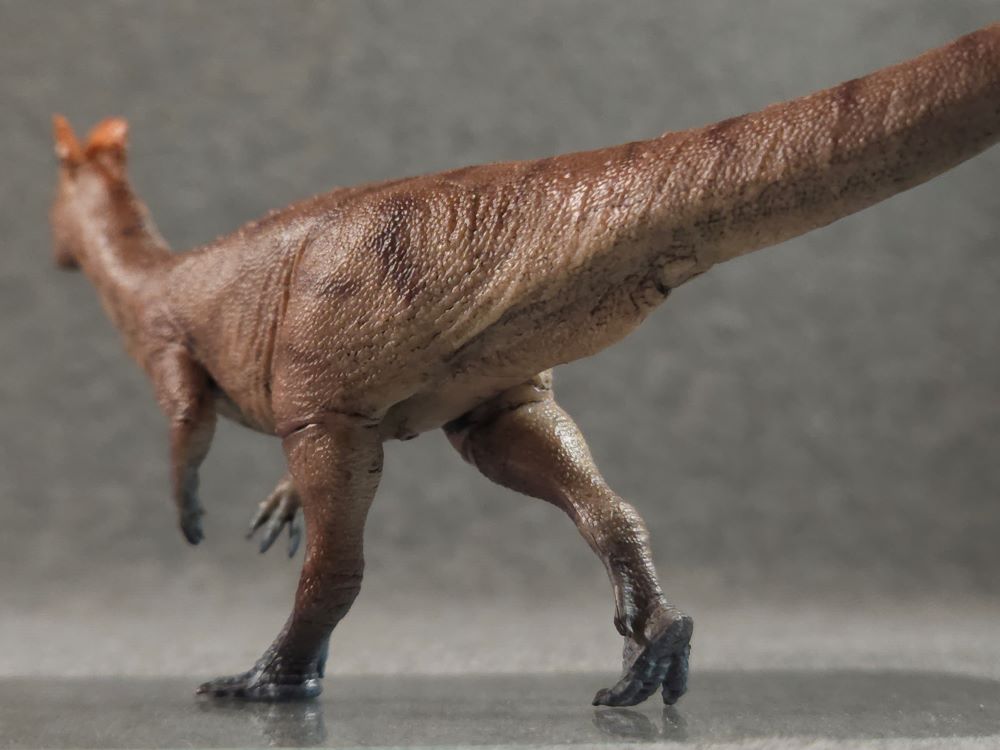
Both animals feature tall, D-shaped crests, for which the dinosaur is named; the crests also display the revised features described in a major paper by Adam Marsh and Timothy Rowe from 2020, which reexamined all known Dilophosaurus fossil material to better understand the animal. The crests, instead of delicately sprouting from the top of the skull, are now depicted larger than before, fully integrated as sturdy extensions of the snout cavities, with a keratinous-looking surface starting on the sides of the face and extending to the nostrils and behind the eyes. The skull as a whole is also a little better defined than in some toy predecessors – although it still lacks some of the robustness seen in artist Brian Engh’s new skull reconstruction, which accompanied the paper and related publications. Despite their mouths being closed, Haolonggood opted to expose the teeth of the upper jaw, probably for visual effect. This is a less favorable choice, in my opinion; not only is current science leaning towards lipped theropods, but the paint application on all my individuals’ teeth is rather sloppy. Granted, these are very tiny teeth, but a lipped reconstruction would have avoided the risk entirely and been more up-to-date for the choice as well.
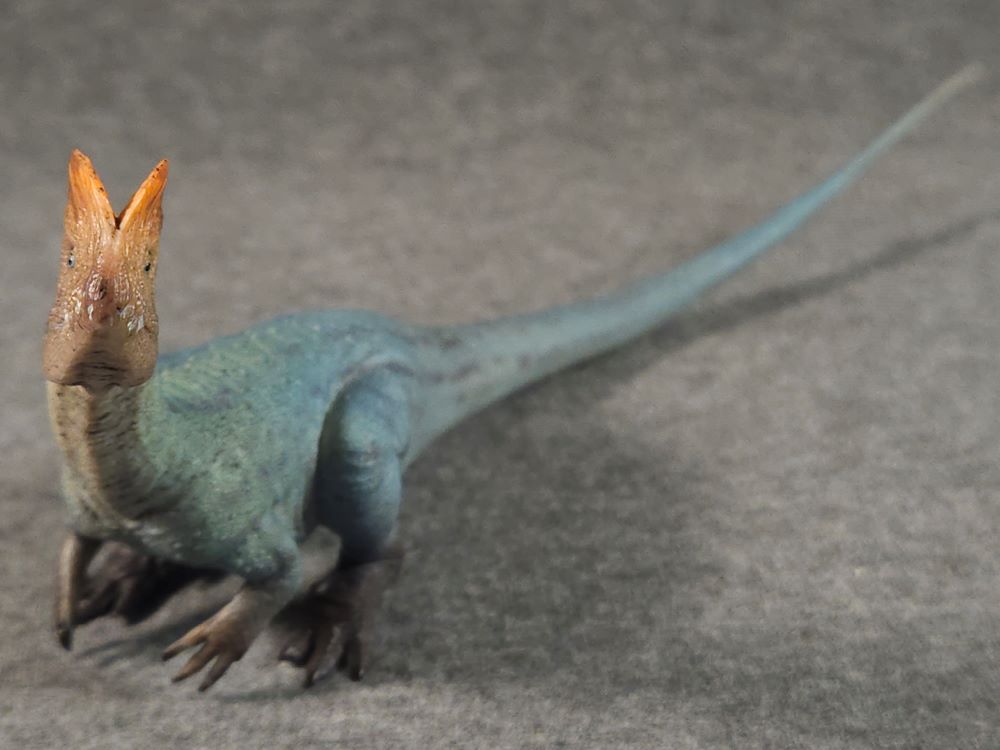
In addition to their different poses, the two Dilophosaurs can be distinguished by numerous anatomical differences, probably representing sexual dimorphism. While both individuals bear their signature large crests, the standing figure’s crests have scalloped edges and irregular outlines, whereas the sitting model has rounder and smoother-edged crests. A row of spiked scales runs halfway down the neck of each figure, but the spikes are more prominent on the standing figure; this figure also bears rugose scales at the base of the throat, which the sitting figure does not. The sitting figure, meanwhile, has a faintly deeper skull and jaw; it also has the broader torso and tail of the two. Seeing toy dinosaurs with such distinguishing individual features is quite unusual, and goes a long way to suggest the level of thought Haolonggood put into this paired release.


The most striking anatomical difference between the two figures, however, is also the most peculiar. When inspecting the base of the standing figure’s tail, there are two bulges just behind the cloacal slit – what appear to indicate male reproductive organs. While this should be further evidence of Haolonggood’s impressive attention to detail, it might prove to be a more questionable choice. Modern archosaurs (crocodilians & birds) don’t have genitals which look like this; only snakes and lizards have what are known as hemipenile bulges, a twin set of male genitals housed in the tail region by the cloaca. It seems unlikely dinosaur like Dilophosaurus would have these body parts, when none of their closest living relatives display them. Their inclusion on the figure is a nice gesture for realism, but the result may not be so realistic as intended.
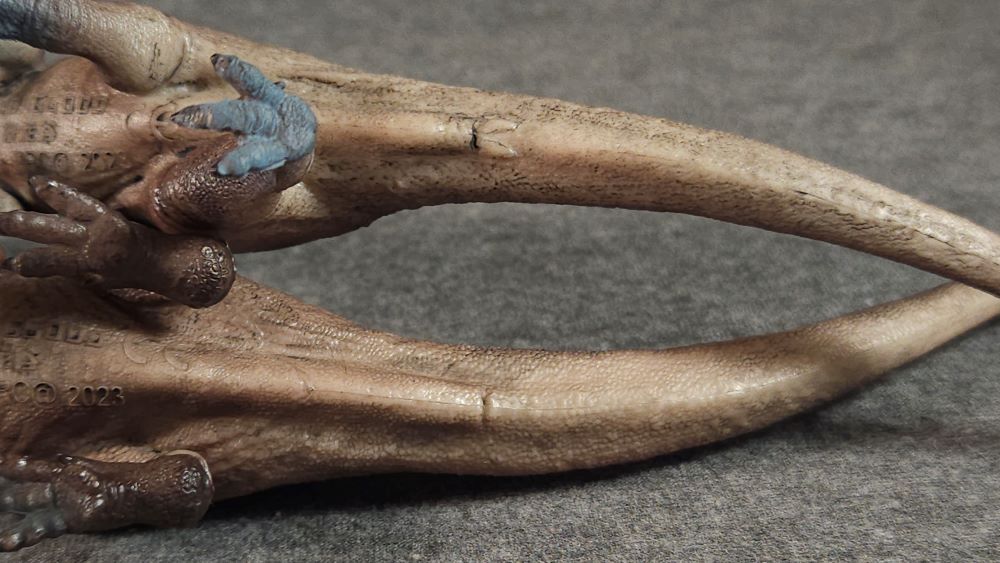
As finely sculpted as the pair is, there are additional conundrums to the design worth noting. With apologies to the fine craftsmen (or women?) at Haolonggood, this section will attempt a more rigorous breakdown of the figures’ dimensions than I usually apply to my reviews; please take this as a reflection for my fondness of this dinosaur and the care I wish to convey towards this release, for which my anticipation was rather high. Reconstructing dinosaurs is always a challenge, especially when the specimens available are incomplete; but with the publication of the Marsh 2020 paper and its supplementary materials, plus several attempts by artists at revised skeletals since then, we have some fairly solid measurements to use as a base of reference. Using UCMP 77270, the largest Dilophosaurus specimen, for the base to scale from, I measured specific proportions of the individual figurines to compare – and then measured them again, and double-checked and triple-checked the data for all three “specimens”. I finally put together a couple of tables to organize the results as neatly as possible. The results are as follows:
| UCMP 77270 | Standing figurine | Sitting figurine | |
| Total length | 7.3 m (23 ft) | 210 mm (8 in) | 220 mm (8.9 in) |
| Skull | .688 m (2.26 ft) | 21 mm (.83 in) | 21 mm (.83 in) |
| Snout-sacrum | 3.2 m (10.5 ft) | 85 mm (3.35 in) | 90 mm (3.54 in) |
| Femur | .614 m (2.01 ft) | ~ 20 mm (.79 in) | ~ 20 mm (.79 in) |
| Hip height | 1.7 m (5.58 ft) | 50 mm (2 in) | NA |
| UCMP 77270 | Standing figurine | Sitting figurine | |
| Total length | 1:1 | 1:35 | 1:32 |
| Skull | 1:1 | 1:33 | 1:33 |
| Snout-sacrum | 1:1 | 1:38 | 1:36 |
| Femur | 1:1 | 1:31 | 1:31 |
| Hip height | 1:1 | 1:34 | NA |
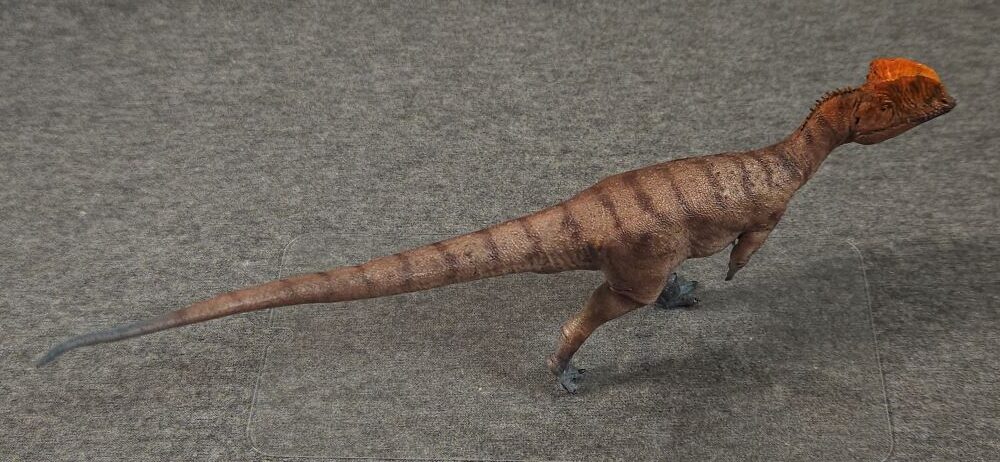

As you can hopefully tell, the anatomies of these figures bear some issues. Being a dimorphic pair, some variation between the two is expected; yet each figure on its own has inconsistencies. Between the two, the biggest discrepancy appears to be in the length from snout to sacrum (the base of the spine), which is too short in comparison to the skull and limbs, possibly by as much as a fifth in total. Dilophosaurus was a more lanky-bodied animal than the average allosaur and tyrannosaur. Perhaps shaving a centimeter off the tail and adding that to the torso would even things out? It’s also possible the neck could be longer in relation to the skull, and the metatarsals might be a bit too long compared to the rest of the leg. It’s a tricky balance to manage everything in miniature, a balance that I’m sure I’m underestimating when it comes to the modeling craft. Considering the care given to balancing the standing figure properly, I wouldn’t be surprised if some discrepancies in the anatomy were just sacrifices to ensure the figure’s weight was evenly spread. That is pure speculation on my part, of course; to my knowledge Haolonggood’s staff have not divulged details on their design choices. The bottom line to all this is: Haolonggood’s Dilophosaurs are close, but not quite all the way, to fully capturing the updated appearance of the double-crested dinosaur.

The inclusion of two figurines per package offered Haolonggood an opportunity to experiment with their color variants in a unique way. Collectively, the four Dilophosaurus figures are less extravagantly colored than some of Haolonggood’s other dinosaurs; but the sexual dimorphism approach is something we don’t see often in the toy dinosaur market. Sun Xin + Gu da sao, the brown pair, are indeed predominantly a ruddy brown in color with darker brown patterns running the length of the bodies: the standing figure has perpendicular short stripes, while the sitting figure has parallel irregular lines of spots. Both figures have bright orange crests, although the sitting figure’s crests are more of a yellow-to-orange gradient. The Standing figure has some additional blue highlights on its hands, feet, and tail.
Wang Ying + Hu Sang Niang, the blue/yellow pair, are not so similar to each other. While the striped/spotted patterns are shared with Sun Xin + Gu da sao, the Wang Ying + Hu Sang Niang pair are immediately distinct from each other in coloration. The standing figure is mostly a sandy yellow-brown in color, contrasting with the earthy brown striping, with a faint black wash to bring out the finer texture of the sculpt. The crests are a subdued burgundy. The sitting figure, meanwhile, is a light aqua blue with slightly purplish patterns, and the neck & head transitioning into a dirty greenish yellow before blending with the bright orange crests. It’s very interesting to see the “female” figure get the more colorful treatment of the two; although sexual dimorphism typically favors the male as the showy partner, there are a few instances of the reverse known in nature, so it’s a nifty change of pace to see Haolonggood go the less-beaten route for this set. As always, one can argue the (un)likelihood of certain color schemes for such animals, but Haolonggood has delivered an attractive and distinct pair of releases to appeal to different collecting sensibilities. For my money, blue/yellow are the winning pair.

There is one more detail I feel is worth examining on these figures… Although it’s really less for critique and moreso just for fun. Among other aforementioned traits, Dilophosaurus is noteworthy for having a number of fossil footprints (presumably) to its name. Fossil trackways can be hard to pin down to specific animals, so they usually get their own unique names for general identification. Fossil footprints found in Utah and other American states, designated under the name Eubrontes, were most likely created by Dilophosaurus or a related theropod, based on their age, size and shape. These Eubrontes didn’t just leave footprints, either: we have impressions of them sitting and resting on the ground! Not many dinosaurs have “butt prints” to their name in the fossil record.
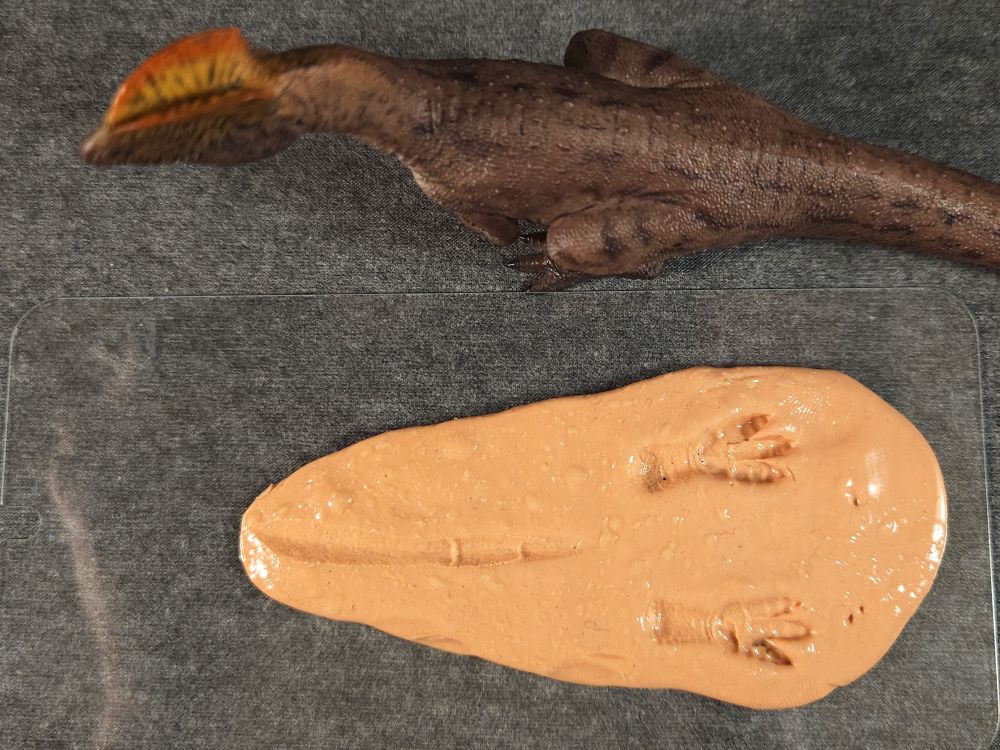
Given that we have legitimate evidence of how Dilophosaurus might have sat, and given Haolonggood went to the effort of producing a sitting Dilophosaurus figure, I couldn’t resist examining to see if Haolonggood went the extra mile in replicating this very specific discovery – which I doubted they had, but it couldn’t hurt to check, right? With the help of a glass phone screen protector and a small glob of silly putty, I successfully sat one of my Dilophosaurus down to produce an impression of its seated posture, for comparison with known fossil impressions. After some rough measurements of a Eubrontes trackway map described in 2009 and my own fresh miniature print, I emerged with the following results:
| Fossil trackway | Haolonggood figure | Est. scale | |
| Heel-to-toe prints | 50-60 cm | 2.5 cm | 1:20-1:24 |
| Heels width | 40 cm | 1.5 cm | 1:27 |
| Feet width | 80 cm | 3.5 cm | 1:23 |
| Hands width | 80 cm | 2 cm | 1:40 |
| Ischium-to-hand prints | 120 cm | 3.5 cm | 1:34 |
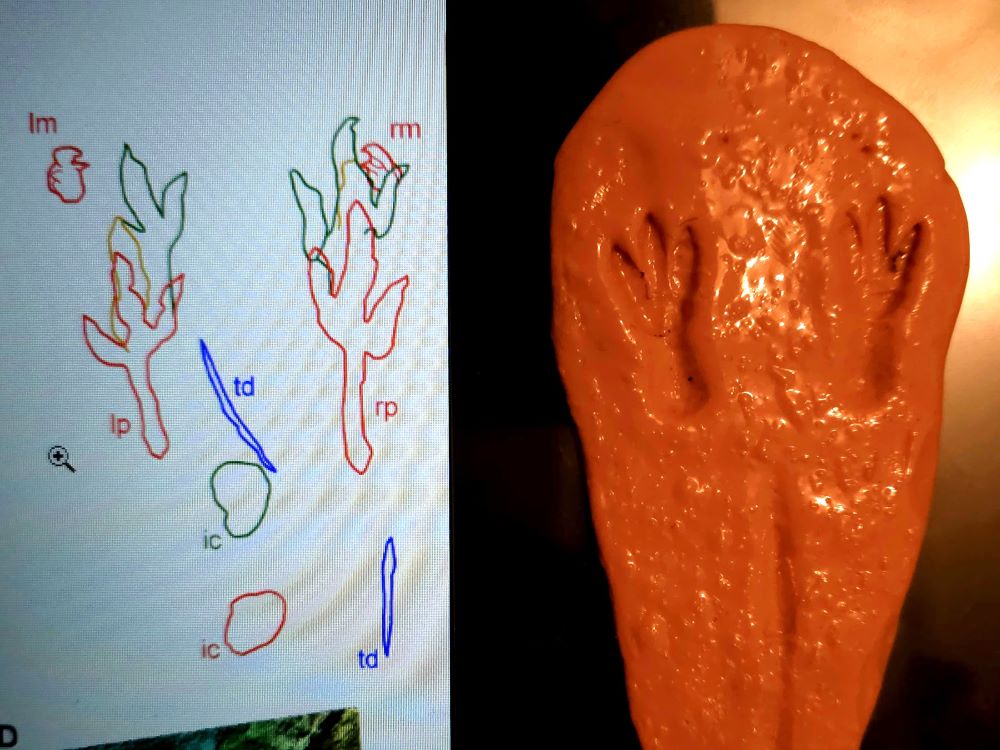
Now, given I had already determined the figurine had variables in body proportions, it’s not surprising the replicated seating print wouldn’t end up matching the trace fossil – or, to put it a better way, this very specific trace fossil available for reference. Individual animals aren’t guaranteed to sit exactly the same way every single time, much less the same way as each other; so even if Haolonggood’s figurine was perfectly proportioned, the sitting impression might not match the trace fossils. What ended up being more interesting than the specific measurements was the way the shape of the real vs toy prints differ. Prints of the feet are much neater from the figure than the live animal, which is to be expected from the contrast of environment. Curiously, the Eubrontes prints suggest a longer middle toe than recreated in the figure – although a notable fossil print from Massachusetts resembles the figure’s print more closely. The figurine sits with its hands still raised off the ground, whereas the Eubrontes fossil captures the animal’s resting hand prints. The figure also captures a lengthy tail print, whereas the fossil features only the “callosity” of the ischium, i.e., the rear hip bone. It’s interesting to ponder how the live animal’s resting choice might have varied, or how the soft tissues of the animal’s underside might have differed from Haolonggood’s rendition.
When all has been said and reviewed, the question remains: is Haolonggood’s figurine set the definitive 2020s toy likeness of Dilophosaurus? My answer to this is… well, no, it’s not. However, that was a pretty tall order to ask. While there are some aspects to the design that could use improvement, there are a lot of other aspects worth admiring, scientifically and aesthetically. So far there aren’t a lot of toys & models on the market representing the new look of Dilophosaurus, but Haolonggood has provided a very good example for future figure designers to follow and improve on. If you’re anywhere near as fond of the double-crested reptile as I am, the Haolonggood Dilophosaurus pair comes recommended.
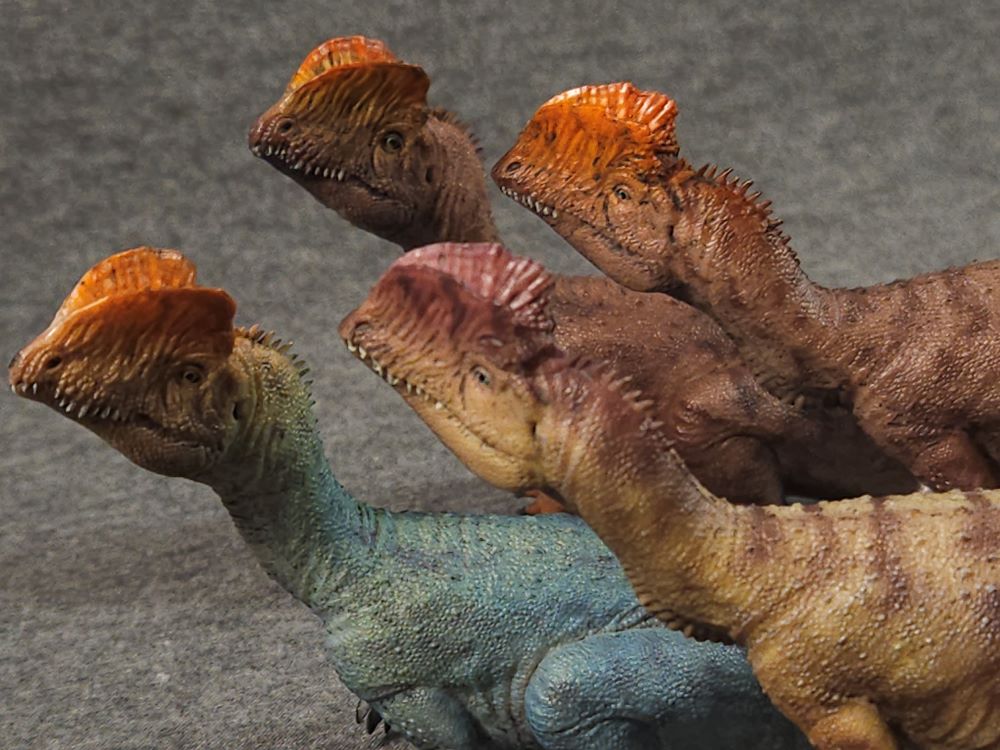
As of this writing, Haolonggood products are available through numerous online retailers, including Happy Hen Toys, Lana Time Shop, and Everything Dinosaur, in addition to AliExpress and Amazon.
Trending Products


